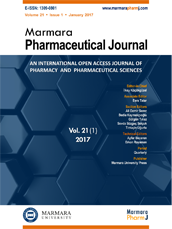Editor-in-Chief
Hatice Kübra Elçioğlu
Vice Editors
Levent Kabasakal
Esra Tatar
Online ISSN
2630-6344
Publisher
Marmara University
Frequency
Bimonthly (Six issues / year)
Abbreviation
J.Res.Pharm.
Former Name
Marmara Pharmaceutical Journal
Marmara Pharmaceutical Journal
2018 , Vol 22 , Issue 1
Determination of antioxidant activities of solvent extracts from an endemic plant: Phlomis leucophracta
1Süleyman Demirel University, Faculty of Pharmacy, Department of Analytical Chemistry, Isparta, Turkey2Süleyman Demirel University, Faculty of Science and Literature, Department of Chemistry, Isparta, Turkey
3Selcuk University, Faculty of Science, Department of Biology, Konya, Turkey DOI : 10.12991/mpj.2018.45 The members of the genus Phlomis have been traditionally used for therapeutic purposes in Turkey. In this study, the antioxidant properties of different extracts from P. leucophracta were investigated. Antioxidant properties were evaluated by different assays including free radical scavenging (DPPH assay), reducing power (potassium ferricyanide method), β-carotene/linoleic acid, metal chelating and phosphomolybdenum. Moreover, total phenolic and flavonoid contents were detected for each extracts. Total phenolic and flavonoid contents were detected as 30.86-55.00 mg GAE/g extract and 4.93-26.09 mg QE/g extract, respectively. The methanol and water extracts exhibited higher DPPH (1,1-diphenyl-2-picrylhydrazyl) radical scavenging and reducing power abilities as compared to ethyl acetate and hexane extracts. The best activity was observed by the hexane extract in β-carotene/linoleic acid assay (94.35% at 2 mg/mL). In metal chelating ability, those samples exhibited the following order (at 0.25 mg/mL concentration): Water (73.90%)>Hexane(64.87%)>Ethyl acetate(4.88%)>Methanol (2.28%). Based on our results, P. leucophracta may be utilized as a natural source of antioxidant compounds in food and pharmaceutical areas. Keywords : Phlomis leucophracta; phenolics; DPPH; antioxidant activity; reducing power

